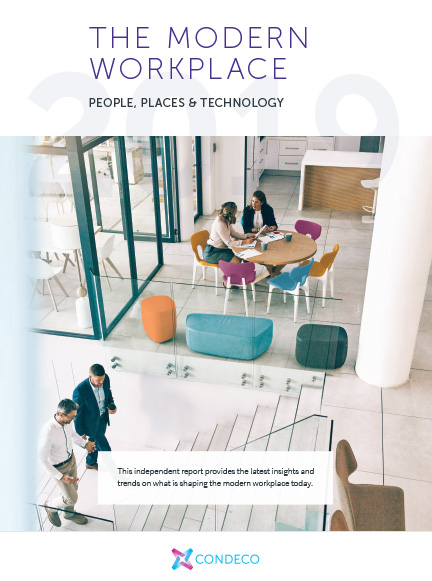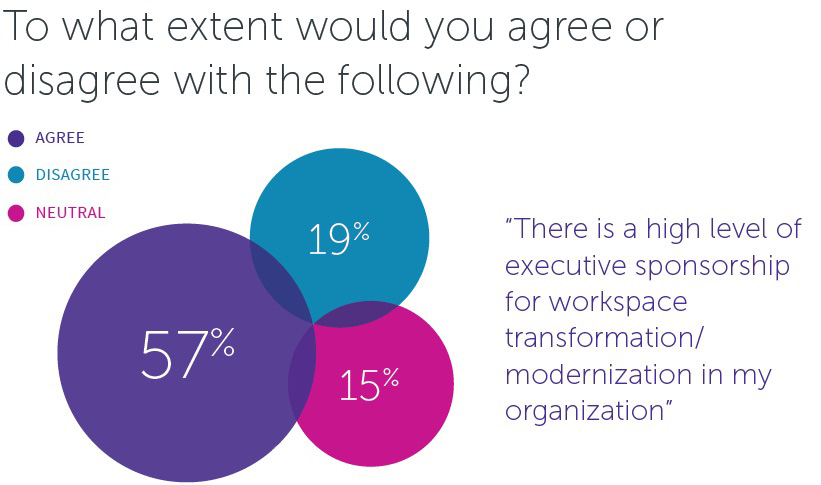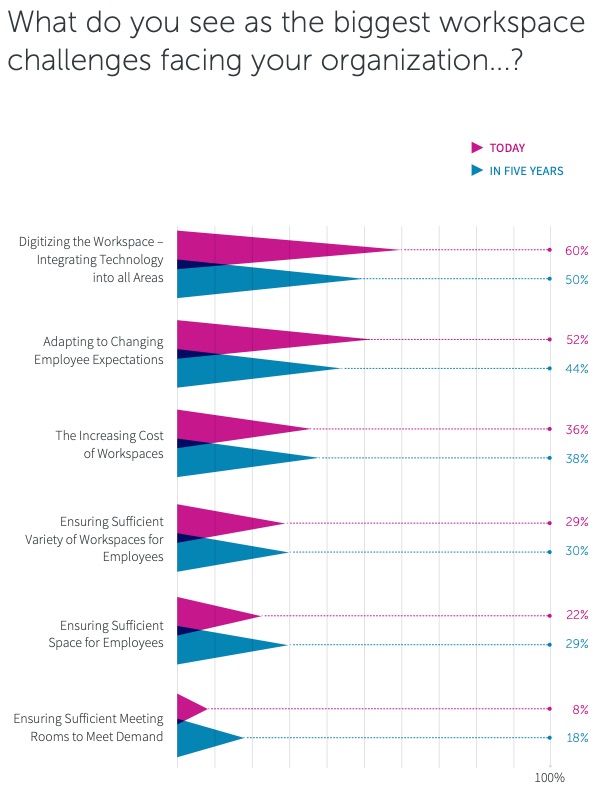
Download the research
Latest insights and trends on what is shaping the modern workplace today.
Introduction
The 2019 edition of the Modern Workplace Research Report looks at the trends driving changes in our working environments, in the context of whether businesses are prepared for what’s ahead. These changes are partly because of advances in technology, but they’re also physical, environmental and cultural: where we work, when we work and how we work are all fundamentally changing, too.
The report will give you valuable statistical insights on four important topics:
- Digital transformation and the workplace: the role of technology in changing our working environments
- Adapting the physical workspace for efficiency: exploring new designs and layouts to better suit workforce needs
- Meeting culture and trends: how employees have embraced collaboration tools and video conferencing
- Flexible working patterns: the ways in which the desk-based nine-to-five culture is becoming a thing of the past
The roadmap to a successful workplace
Sixty percent of global business leaders agree that their biggest current challenge is digitizing their workspace and integrating technology into all areas of their enterprises. But that is by no means their only challenge on the road ahead. How businesses respond to this unprecedented time of change in modern workplaces and working practices will be critical to their future success.
Rapid pace of workplace evolution
The workplace is changing more quickly than at any time since the birth of the PC. The office is evolving from a permanent place of work to a hub that enables workers to turn up when they need to, in order to be productive, either in collaboration with teams, in a meeting or working independently.
The rapid pace of change is putting pressure on business leaders, who need
to understand both how technology is evolving and how that will affect their space needs in the future. Keeping ahead of trends in the workplace is a priority for business leaders across the world. They see it as a key recruitment and retention tool, now more than ever as Millennial and Generation Z entrants to the workforce prioritize greater flexibility at work and quality of space.
The trend towards a more flexible work culture is, if anything, accelerating, as its benefits to management and employees become more evident. Indeed companies are even defining the optimal combination of remote working for productivity reasons, stating that two days remote and three in the office are most common (49 percent) for employees who work flexibly.
As companies look to offer more flexible working and increased remote
working, new technology that helps employees to use space more efficiently, and to be more productive is deemed critical.
“Our new offices will have far more, smaller flexible meeting spaces that people can use without booking and we will also have several larger conference rooms.”
USA, Office & Facilities Manager
Priorities for change
Taking advantage of new technology to use space more effectively was considered the most important challenge in the UK, the USA and Singapore. We are also seeing a shift away from a narrow focus on reducing space usage, to one that focuses on effectiveness of the provision of space.
Bearing this in mind, companies should consider data-driven design. Data that focuses on usage, utilization and satisfaction, can help make better design decisions. With the right information, it is possible to improve layouts and facilities to encourage employee productivity, overall satisfaction and employee wellbeing.
If businesses are to exploit the prevailing trends fully they need to remember that the employee experience is key. People want to be able to work where they choose, as far as possible, whether that is in their homes, offices or in third places such as cafes and co-working spaces. Most respondents around the world are aware of the increasing need to transform the physical work environment to address these trends, with 56 percent saying it is fairly important, and 29 percent saying it is very important to modernize their physical spaces.

Trends to inspire
Workplace change is happening increasingly rapidly, but companies are going through the toughest phase now.
We are seeing a growing interest in WaaS – Workspace as a Service, which is liberating organizations from the burden of designing, building and maintaining top-quality workspace. The advantage for some employers will be easy, scalable access to workspace that meets employee’s increased expectations.
Our survey suggests that companies are now in the thick of digitalization and workplace modernization, which is highlighting concerns about how space is used. Yet this challenge looks set to recede in five years’ time. When we asked business leaders to look ahead, they anticipate that ensuring sufficient meeting rooms to meet demand and ensuring sufficient space for employees will be much less of a challenge than it is now, citing a 63 percent decrease in the issue over the next 5 years.
The cloud and moving to the cloud, is still considered a challenge by business leaders but as the transition is achieved by more companies, business leaders will appreciate the advantages that connected cloud solutions can offer the employee and the business. Tasks that are started in the office, can carry on seamlessly at home. This way employers can create a workspace for their needs.


Download the full research
The successful workspace of future will be one which meets the needs of the people who use it, integrating their preferred technology seamlessly and creating a hub they want to be a part of.


